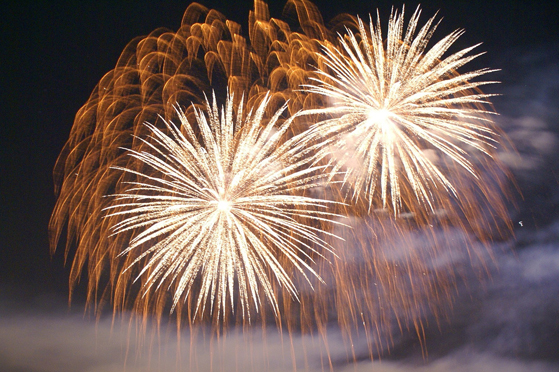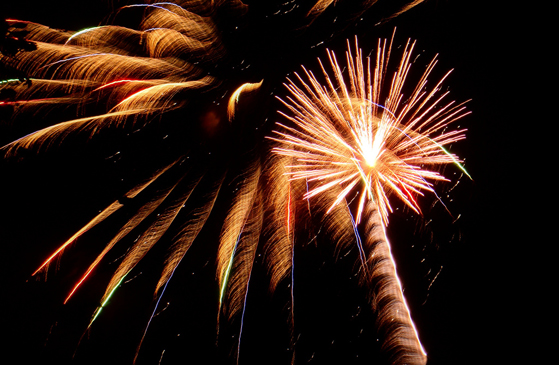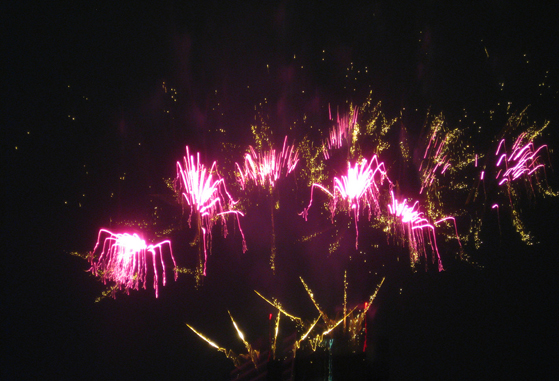A guide to the different fireworks you'll see July 4th, and how to snap great photos of them.
Shortly after finalizing the Declaration of Independence, John Adams wrote that Independence Day "ought to be solemnized with pomp and parade, with shows, games, sports, guns, bells, bonfires, and illuminations, from one end of this continent to the other, from this time forward forever more."
While you're out celebrating the founding of our fine nation, it's easy to snap snazzy photos of those "bonfires and illuminations."
There's no great secret—most cameras, even smartphones, can capture decent photos of fireworks. But if you want to squeeze a little bit of extra sparkle out of your skyrocket snapshots, take a few simple steps.

Hold the Camera Steady – Brace it against a table or on your knee, or lean against a pole or wall while you shoot, or even better, use a tripod. As bright as the trails and sparkles are, you're still taking a photo in dim lighting, and motion blur can be a problem.
Use a Slow Shutter Speed – Want dramatic trails? Slow down the shutter. Interchangeable lens cameras and advanced compacts have manually adjustable shutter speeds. Set the camera to shutter priority mode, pick your desired shutter speed (start with something around a half-second, and experiment from there), and let the camera select the proper ISO and aperture settings for you.
Cheaper compacts usually have scene modes that decrease the shutter speed a bit—look for settings with the word "night" in them. And if you're using a smartphone, download an app that lets you set (or simulate) a slow shutter speed, like Top Camera for iPhone or Camera FV-5 for Android.
TYPES OF FIREWORKS
Now that you know how to get decent photos of fireworks, here's a handy guide to spotting the different styles. Bonus points if you can snag a picture of each type!
Peony – Perhaps the most common fireworks effect, peony shells explode in a globular fashion. Unlike chrysanthemum effects, the tips of the flame trails are usually more pronounced, and sometimes a different color.
Chrysanthemum – Also common, the chrysanthemum effect is a dense, global burst of pyrotechnic stars that leaves a trail of sparks. This trail of fire is what separates it from the peony.
Palm – Palm effects—not surprisingly—resemble palm trees. A comet star leaves a bright, thick tail (or tree trunk) as it ascends, and the flame trails from the main explosion create large tendrils that look like palm fronds.

Crossette – Crossette effects burst in a series of fast, crisscrossing patterns. This is because stars in a crossette shell are packed in a specific manner that effectively divides them into four segments once ignited.
Willow – Perhaps the most self-explanatory fireworks effect, the willow looks just like a willow tree. It explodes much like a chrysanthemum or peony, but the flame trails extinguish more slowly, which creates a willow branch effect as they succumb to gravity.
Multi-break – Also called a bouquet, a multi-break shell contains several smaller shells of various types and sizes. An initial explosion scatters the smaller shells across the sky before they burst, creating a large, vibrant pattern of random colors and effects.

Spider – Spider shells burst very powerfully, causing the flames trails to fire very quickly across the sky and then gradually ascend. The result is something that looks like the legs of a spider.
Kamuro – Named after a Japanese hairstyle, this effect maintains bright flame trails but begins to ascend relatively quickly. It gives the appearance of a boy’s haircut.




0 comments:
Post a Comment